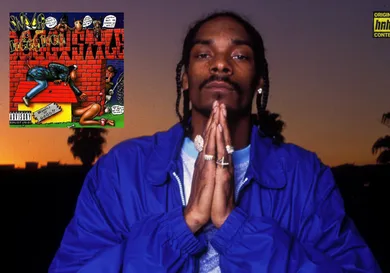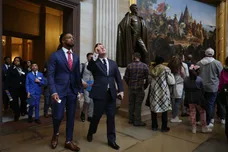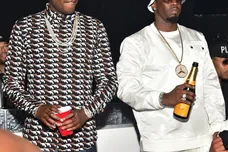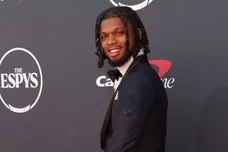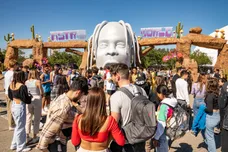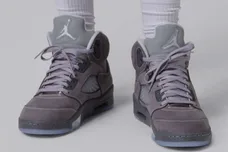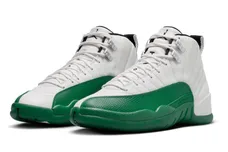Snoop Dogg’s first album Doggystyle turns 26, tomorrow, November 23rd, 2019. Between the release of his debut album and now, Snoop has gone from hyper-controversial figure to Martha Stewart collaborator. Has a 180 ever been so unprecedented? Doggystyle was heavily influenced by Dr. Dre, artwork included. According to the story, Dre came up with the concept for the album art and Snoop enlisted his cousin, Darryl ‘Joe Cool’ Daniel, to execute it. What Daniel created became an emblem of provocation in a heated public discourse over censorship and obscenity.
Snoop Dogg poses during a portrait session, 1998 - Estevan Oriol/Getty Images
The album art Daniel designed is busy and colorful in the style of a comic book. It pictures a dog wearing a hat, a long checkered coat, and a gold chain straddling the top of a red and yellow dog house. He’s leaning over the edge, reaching his hand (paw?) toward something—it’s a female dog’s hindquarters. The female dog’s front half is obscured by the doghouse and the only indication that the legs depicted are canine rather than human is her tail. She’s wearing lingerie. In the background, behind a brick wall, a human dogcatcher with a large net lurks, observing the dogs. On top of the brick wall are three dogs variously quoting George Clinton’s “Atomic Dog”: “Why must I feel like dat?”, “Why must I chase da cat?” and, “Nuttin’ but da dogg in me!!”.
Snoop Dogg's "Doggystyle" cover artwork, 1993
Doggystyle is now recognized as a game-changing album that solidified g-funk’s place in the rap pantheon, but at its birth, it made headlines for its salacious elements. The most striking and immediately graspable element was the album art. Daniel’s work was undeniably lascivious, which prompted the D.C. subcommittee on Commerce, Competitiveness, and Consumer Protection to include Doggystyle as evidence in its congressional hearing. The art as well as the musical content was condemned as obscene and degrading to women. Freedom of expression, though, is a fundamental tenet of the Bill of Rights and the congressional hearings only increased Snoop’s visibility and album sales.
The inside sleeve is far more provocative than the album cover. In eight frames it tells a story that at the very least offends law enforcement officials and women. But for all of its incitement, Daniel’s work has humorous, artistic, and entertainment value. The cover of Doggystyle alludes to a host of different cultural icons. The sexualization of the female dog’s body is Jessica Rabbit-esque and the dog house imagery hints at The Peanuts’ Snoopy. Daniel’s art pays homage to George Clinton and Parliament-Funkadelic in more ways than simply quoting “Atomic Dog” and the famous “Bow-wow-yippie-yo-yippie-yeah” refrain. Parliament-Funkadelic’s maximalist album covers are immediately recognizable by their swirl of psychedelic colors and mix of photo collage and illustration. Daniel channeled the same busy aesthetic that reveals more richness and density the longer you examine it.
Doggystyle is such an iconic album that its legacy goes far beyond sound alone. The influence of its visual art and the concept behind it can still be seen in album designs today. Daniel’s art was especially notable because it took a medium that is traditionally geared toward children (cartoons) and made it explicit by infusing it with adult themes. At the time, The Simpsons existed but we were not yet in the current world in which the programming options for adult cartoons are vast. In 1993, the shock value of adult-ifying cartoon imagery was attention grabbing, but it has since become a staple in the world of hip-hop album art. Let’s take a look at some of the album covers that can trace their origins back to Daniel’s work for Doggystyle.
- Vince Staples’ FM! album art looks like a California-themed Where’s Waldo. Amongst the diverse beach goers is a bunny with a giant syringe and an on-fire trashcan. FM! takes the idea of a children’s book and repurposes it to suit a more adult taste. Even if Staples did not set out to allude to Daniel’s Doggystyle art intentionally, the latter’s influence on the look of rap album art runs so deep that every cartoon-stylized album is, in a sense, an inheritor of Daniel’s artistic vision.
- Gucci Mane’s droptopwop mixtape art is a riff on the suburban image of children chasing an ice cream truck in the summer. But instead driving a confectionary vehicle, Gucci Mane and Metro Boomin cruise in a Rolls and toss bills behind them. The subversion of the Americana image of an ice cream truck is a clever take on an iconic and historical theme.
- Lil Tecca’s art for We Love You Tecca is not explicit in any way— but it leans into the children’s illustration look so much that it becomes a caricature of it. Tecca wraps his arms around an Earth where every continent is heart-shaped. There’s something very Raffi about the wholesome-ness of the art. All three of these albums share with Daniel’s Doggystyle illustration a ‘zine quality and a street art sensibility that makes the art feel very handmade and personal.
- Consider Tory Lanez’s Love Me Now? cover. It’s an evolved version of what Doggystyle introduced the world, combining two unexpected children’s-facing programs. First, the blue background segmented into squares is a callback to The Brady Bunch. Second, the rapper has a double in a Jim Henson muppet-like character, who is smoking something in one of the squares. The conflation of two separate kid-friendly shows on an album cover is an oblique consequence of the trend Daniel started years ago.
- On KOD, J. Cole makes a statement about what he sees as the problem with kids these days. The album art is a grotesque depiction of kids doing drugs. The most disturbing feature is that the kids do not look like teenagers but adolescents. Their large eyes make them appear extremely young and the cautionary message is evident from the skeletal heads looming behind them. The fact that the cover art is in the style of an impressionist oil painting heightens the discomfiting sensation of witnessing kids do drugs. Just as the cartoon style of Daniel’s depiction of hyper-sexualized dogs emphasized the explicitness of his content, so too does the oil painting medium emphasize the upsetting weirdness of children abusing drugs.
Daniel has influenced the look of hip-hop album art for decades now. Not only has he continued to work with Snoop on numerous projects, but he has been commissioned by other musicians and global brands. Daniel’s designs have been featured by Supreme, Adidas, and 7-Eleven. At this point, his design style is so embedded in the hip-hop world that you do not have be familiar with his Doggystyle art to be influenced by his style. Daniel’s is part of a collective cultural consciousness that transcends trends and has become living history.
